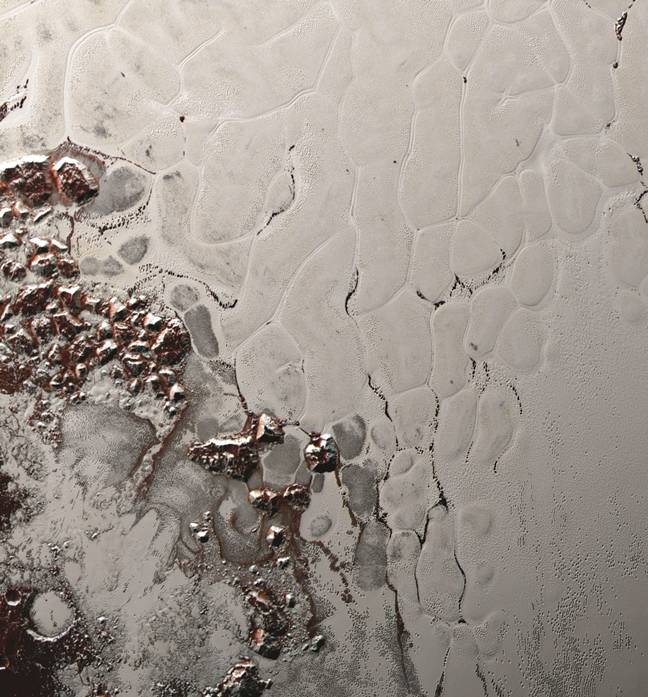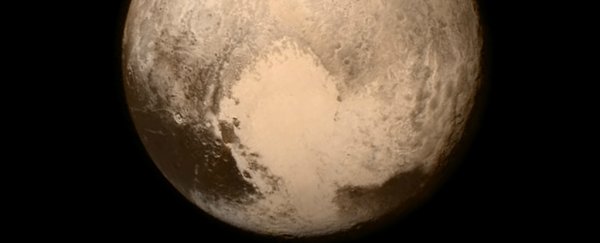Last year, thanks to NASA's New Horizons spacecraft, we finally got a chance to see Pluto - the icy dwarf planet that lies at the edge of our Solar System - up-close and personal. While the photos offered a plethora of scientific data for researchers to pore over, the world was captivated by something else entirely: a giant heart-shaped region that takes up a large chunk of the planet's surface.
This region is known as Sputnik Planum, but many simply refer to it as Pluto's heart, and now a new study has revealed that it might be 'beating', which appears to keep the famed region looking fresh and young, compared to the rest of the dwarf planet.
Obviously, Pluto doesn't actually have a heart that pumps blood like ours do because, you know, it's an icy dwarf planet. But according to two new studies – one by researchers from Washington University and another from a separate team at Purdue University – Pluto's heart 'beats' when warm nitrogen ice rises upwards, spreads along the surface, and freezes over Sputnik Planum.
This constant 'beating' spreads new ice over the region, erasing craters and keeping Pluto's heart looking pristine, reports Nadia Drake for National Geographic.
In other words, Pluto's geological heart beat causes a constant pump of ice to form over the heart-shaped region just like our hearts pump blood that occasionally has to pool and scab over to heal our wounds.
"Not only is it the heart of Pluto, it's the beating heart," Bill McKinnon of Washington University told National Geographic. "There are actually things happening. If we were to come back in 100,000 years, the pattern would be markedly altered."
The best way to envision this newly found geological process is imagine oatmeal bubbling on a stove.
"You will see that the surface will separate into polygonal terrain," said Alexander Trowbridge from the Purdue team to National Geographic. "If the stove is on, the centres of the polygons will be raised, but if you turn the stove off, the centres of the polygons collapse."
This stove, according to Drake, might be powered by radioactive elements inside Pluto, and the heat these elements generate warm up the polygonal regions, which stretch about six to 25 miles (10 to 40 kilometres) across.
These findings offer a possible answer as to why Sputnik Planum looks the way it does, which has been a question on scientist's minds since New Horizons performed its flyby last year.
This region stretches 745 miles (1,200 kilometres) across, and appears young compared to the rest of Pluto. It's also covered in a weird polygonal pattern, which the Purdue team says is likely a sign that warmer nitrogen ice may linger under it:
 NASA
NASA
Since radioactive materials are constantly churning out heat and, therefore, cooking up nitrogen ice, Pluto's heart gets covered with new ice roughly every 500,000 to one million years, meaning Sputnik Planum likely looked different many years ago, and will probably look different in the future. So don't get too attached to that heart shape. 🙁
Both of the teams came to their conclusions by using computer models that simulated their nitrogen ice hypothesis over the course of a million years. When the model was finished calculating, the teams were both left with a result that resembled exactly what is seen in the New Horizons images.
While the researchers generally agree on how the basic process works, they differ slightly on some of the minor details, such as how deep the nitrogen ice layer is. But that's okay, because both teams seem to enjoy the difference of opinion.
"I'm more excited about the similarities between the two papers," Trowbridge said. "Our results are very similar, which is what you want to see in science."
Until now, researchers have known that Pluto was geologically active, but they hadn't any idea why. These new studies offer one possible answer to that mystery, which has many other scientists pretty excited.
"The findings offer additional insight into the unusual and highly active geology on Pluto and, perhaps, other bodies like it on the outskirts of the solar system," the New Horizons team said in a statement.
The next step will be to find out why Sputnik Planum is the only region on the dwarf planet that has so much nitrogen ice, though a study looking into that question has yet to be announced.
Both papers were published in the journal Nature, here and here.
